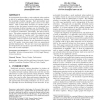Free Online Productivity Tools
i2Speak
i2Symbol
i2OCR
iTex2Img
iWeb2Print
iWeb2Shot
i2Type
iPdf2Split
iPdf2Merge
i2Bopomofo
i2Arabic
i2Style
i2Image
i2PDF
iLatex2Rtf
Sci2ools
94
Voted
DIALM
2008
ACM
2008
ACM
Latency of opportunistic forwarding in finite regular wireless networks
In opportunistic forwarding, a node randomly relays packets to one of its neighbors based on local information, without the knowledge of global topology. Each intermediate node continues this process until the packet arrives at its destination. This is particularly attractive in certain types of wireless ad hoc and sensor networks where obtaining accurate knowledge of global topology may be infeasible. However, opportunistic forwarding is hampered by the difficulty to control its performance, particularly, the end-to-end latency. This paper presents new analytical results that shed light on the latency of "random walk", the simplest type of opportunistic forwarding, for several useful regular network topologies, such as r-nearest cycle that can model variable wireless transmission distance in one dimensional scenario, and a 2D regular torus-type graph that can approximate grid-like deployments. We give new exact and approximation formulas for the maximum expected hitting tim...
Related Content
| Added | 19 Oct 2010 |
| Updated | 19 Oct 2010 |
| Type | Conference |
| Year | 2008 |
| Where | DIALM |
| Authors | Prithwish Basu, Chi-Kin Chau |
Comments (0)

